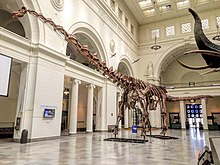
Back Titanosauria AF تيتانوصوريات Arabic تيتانوصوريات ARZ Titanosaures Catalan Titanosauria Czech Titanosaur Danish Titanosaurier German Titanosauria Spanish تیتاناسور FA Titanosauria Finnish
Titanosaurs (or titanosaurians; members of the group Titanosauria) were a diverse group of sauropod dinosaurs, including genera from all seven continents. The titanosaurs were the last surviving group of long-necked sauropods, with taxa still thriving at the time of the extinction event at the end of the Cretaceous. This group includes some of the largest land animals known to have ever existed, such as Patagotitan, estimated at 37 m (121 ft) long[15] with a weight of 69 tonnes (76 tons),[16] and the comparably-sized Argentinosaurus and Puertasaurus from the same region.
The group's name alludes to the mythological Titans of ancient Greek mythology, via the type genus (now considered a nomen dubium) Titanosaurus. Together with the brachiosaurids and relatives, titanosaurs make up the larger sauropod clade Titanosauriformes. Titanosaurs have long been a poorly-known group, and the relationships between titanosaur species are still not well-understood.
- ^ Averianov, A.O.; Lopatin, A.V. (2020). "An unusual new sauropod dinosaur from the Late Cretaceous of Mongolia". Journal of Systematic Palaeontology. 18 (12): 1009–1032. Bibcode:2020JSPal..18.1009A. doi:10.1080/14772019.2020.1716402. S2CID 214244529.
- ^ Gorscak, E.; O'Connor, P.M.; Stevens, N.J.; Roberts, E.M. (2014). "The basal titanosaurian Rukwatitan bisepultus (Dinosauria, Sauropoda) from the middle Cretaceous Galula Formation, Rukwa Rift Basin, southwestern Tanzania". Journal of Vertebrate Paleontology. 34 (5): 1133–1154. Bibcode:2014JVPal..34.1133G. doi:10.1080/02724634.2014.845568. S2CID 677002.
- ^ Averianov, A.O.; Sues, H.D. (2017). "Review of Cretaceous sauropod dinosaurs from Central Asia". Cretaceous Research. 69: 184–197. Bibcode:2017CrRes..69..184A. doi:10.1016/j.cretres.2016.09.006.
- ^ Martínez, R.D.; Lamanna, M.C.; Novas, F.E.; Ridgely, R.C.; Casal, G.A.; Martínez, J.E.; Vita, J.R.; Witmer, L.M. (2016). "A Basal Lithostrotian Titanosaur (Dinosauria: Sauropoda) with a Complete Skull: Implications for the Evolution and Paleobiology of Titanosauria". PLOS ONE. 11 (4): e0151661. Bibcode:2016PLoSO..1151661M. doi:10.1371/journal.pone.0151661. PMC 4846048. PMID 27115989.
- ^ Han, F.; Yang, L.; Lou, F.; Sullivan, C.; Xu, X.; Qiu, W.; Liu, H.; Yu, J.; Wu, R.; Ke, Y.; Xu, M.; Hu, J.; Lu, P. (2024). "A new titanosaurian sauropod, Gandititan cavocaudatus gen. et sp. nov., from the Late Cretaceous of southern China". Journal of Systematic Palaeontology. 22 (1). 2293038. Bibcode:2024JSPal..2293038H. doi:10.1080/14772019.2023.2293038.
- ^ Wang, X.; Bandeira, K.L.; Qiu, R.; Jiang, S.; Cheng, X.; Ma, Y.; Kellner, A.W. (2021). "The first dinosaurs from the Early Cretaceous Hami Pterosaur Fauna, China". Scientific Reports. 11 (1): 14962. Bibcode:2021NatSR..1114962W. doi:10.1038/s41598-021-94273-7. PMC 8361124. PMID 34385481.
- ^ a b c d Cite error: The named reference
wilson03was invoked but never defined (see the help page). - ^ Mannion, P.D.; Upchurch, P.; Jin, X.; Zheng, W. (2019). "New information on the Cretaceous sauropod dinosaurs of Zhejiang Province, China: impact on Laurasian titanosauriform phylogeny and biogeography". Royal Society Open Science. 6 (8): 191057. Bibcode:2019RSOS....691057M. doi:10.1098/rsos.191057. PMC 6731702. PMID 31598266.
- ^ Mo, Jinyou; Ma, Feimin; Yu, Yilun; Xu, Xing (9 December 2022). "A New Titanosauriform Sauropod with An Unusual Tail from the Lower Cretaceous of Northeastern China". Cretaceous Research. 144: 105449. doi:10.1016/j.cretres.2022.105449. ISSN 0195-6671. S2CID 254524890.
- ^ Pereira, P. V. L. G. C.; Bandeira, K. L. N.; Vidal, L. S.; Ribeiro, T. B.; Candeiro, C. R. A.; Bergqvist, L. P. (2024). "A new sauropod species from north-western Brazil: biomechanics and the radiation of Titanosauria (Sauropoda: Somphospondyli)". Zoological Journal of the Linnean Society. doi:10.1093/zoolinnean/zlae054.
- ^ Gallina, P.A.; González Riga, B.J.; Ortiz David, L.D. (2022). "Time for Giants: Titanosaurs from the Berriasian–Santonian Age". In Otero, A.; Carballido, J.L.; Pol, D. (eds.). South American Sauropodomorph Dinosaurs. Record, Diversity and Evolution. Springer. pp. 299–340. doi:10.1007/978-3-030-95959-3. ISBN 978-3-030-95958-6. ISSN 2197-9596. S2CID 248368302.
- ^ Santucci, R.M.; Filippi, L.S. (2022). "Last Titans: Titanosaurs From the Campanian–Maastrichtian Age". In Otero, A.; Carballido, J.L.; Pol, D. (eds.). South American Sauropodomorph Dinosaurs. Record, Diversity and Evolution. Springer. pp. 341–391. doi:10.1007/978-3-030-95959-3. ISBN 978-3-030-95958-6. ISSN 2197-9596. S2CID 248368302.
- ^ Poropat, S.F.; Kundrát, M.; Mannion, P.D.; Upchurch, P.; Tischler, T.R.; Elliott, D.A. (2021). "Second specimen of the Late Cretaceous Australian sauropod dinosaur Diamantinasaurus matildae provides new anatomical information on the skull and neck of early titanosaurs". Zoological Journal of the Linnean Society. 192 (2): 610–674. doi:10.1093/zoolinnean/zlaa173.
- ^ Cite error: The named reference
gorscak19was invoked but never defined (see the help page). - ^ "Giant dinosaur slims down... a bit". BBC News. 10 August 2017. Retrieved 8 April 2020.
- ^ Carballido, J.L.; Pol, D.; Otero, A.; Cerda, I.A.; Salgado, L.; Garrido, A.C.; Ramezani, J.; Cúneo, N.R.; Krause, J.M. (2017). "A new giant titanosaur sheds light on body mass evolution among sauropod dinosaurs". Proceedings of the Royal Society B: Biological Sciences. 284 (1860): 20171219. doi:10.1098/rspb.2017.1219. PMC 5563814. PMID 28794222.
